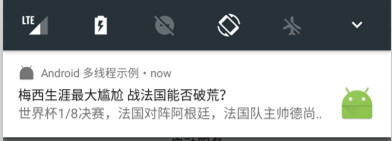1 前台服务
因为服务的优先级较低,所以当系统内存不足时,可能会回收正在后台运行的服务。如果若要避免服务被回收,可以使用前台服务。
前台服务会一直有一个图标在系统的状态栏中显示,下拉状态栏可以看到更加详细的信息,类似于消息通知效果。
public class FirstService extends Service { private static final String TAG = "FirstService"; @Override public void onCreate() { super.onCreate(); Log.d(TAG, "onCreate"); //设置为前台服务 Intent intent = new Intent(this, MainActivity.class); PendingIntent pendingIntent = PendingIntent.getActivity(this, 0, intent, 0); Notification notification = new NotificationCompat.Builder(this) .setContentTitle("梅西生涯最大尴尬 战法国能否破荒?") .setContentText("世界杯1/8决赛,法国对阵阿根廷,法国队主帅德尚将迎来80战里程碑,成为队史执教场次最多的主教练,高卢雄鸡能否保持过去40年世界杯遇南美球队不败的金身,格里兹曼能否找回最佳状态,梅西能否打破此前世界杯淘汰赛666分钟的进球荒,都是此役的关键看点。") .setWhen(System.currentTimeMillis()) .setSmallIcon(R.mipmap.ic_launcher) .setLargeIcon(BitmapFactory.decodeResource(getResources(), R.mipmap.ic_launcher)) .setContentIntent(pendingIntent) .build(); startForeground(1,notification); }} 在此构建出通知对象(Notification)之后,调用 startForeground() 让当前服务变为一个前台服务。
startForeground 接收两个参数:
| 参数 | 说明 |
| id | 通知 ID |
| Notification | Notification 对象 |
效果:

2 IntentService
如果在服务中处理耗时操作,那么容易出现 ANR(Application Not Responding)问题。
为了避免我们可以在主服务的具体方法中开启子线程,然后在子线程中来执行耗时操作,形如:
@Overridepublic int onStartCommand(Intent intent, int flags, int startId) { Log.d(TAG, "onStartCommand"); //在子线程中来执行耗时操作 new Thread(new Runnable() { @Override public void run() { //耗时操作 } }).start(); return super.onStartCommand(intent, flags, startId);} 这样的服务一旦启动后,就会一直处于运行状态,直到调用 stopService() 或者 stopSelf() 才会停止服务。我们可以在耗时操作执行完毕后,调用 stopSelf() ,让服务自行停止:
new Thread(new Runnable() { @Override public void run() { //耗时操作 stopSelf(); }}).start(); Android 提供了 IntentService 类,可以直接创建一个异步、执行完毕会自行结束的服务。
我们新建一个类,让它继承自 IntentService :
public class SecondService extends IntentService { private static final String TAG = "SecondService"; public SecondService() { super("SecondService"); } @Override protected void onHandleIntent(Intent intent) { Log.d(TAG, "子线程 id(Intent 服务): " + Thread.currentThread().getId()); //在此执行耗时逻辑 } @Override public void onDestroy() { super.onDestroy(); Log.d(TAG, "onDestroy"); }} 注意:这个类必须提供一个无参构造函数,并且必须在这个构造函数内部调用父类的有参构造函数。
接着,在活动类中启动 Intent 服务:
Log.d(TAG, "主线程 id: " + Thread.currentThread().getId());Intent intentService = new Intent(context, SecondService.class);startService(intentService);
输出结果:
D/MainActivity: 主线程 id: 1
D/SecondService: 子线程 id(Intent 服务): 145
D/SecondService: onDestroy
从结果中可以看出,IntentService 服务类开启了一个新的线程来执行耗时逻辑,并且在执行完毕后自动停止。是不是很方便呀O(∩_∩)O哈哈~
以上就是本文的全部内容,希望对大家的学习有所帮助,也希望大家多多支持VEVB武林网。
注:相关教程知识阅读请移步到Android开发频道。